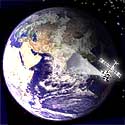What is remote sensing?
16 Apr 2002
Remote sensing is a discipline that helps people get data from a distance by electronic or mechanical means. You need three things for remote sensing:
- sensors, or instruments that can sense ("see", "hear")
- a platform to hold these instruments
- a target or area that needs to be "sensed" or analysed.
 At the simplest level, when you see a distant object through a telescope, you are the platform, the telescope is the instrument, and the distant object is the target. We can do remote sensing through aerial photography from aeroplanes. The best means, for certain kinds of study, especially of the earth, its geography, geology, and weather patterns, is remote sensing with the help of sophisticated instruments on satellites orbiting the Earth.
At the simplest level, when you see a distant object through a telescope, you are the platform, the telescope is the instrument, and the distant object is the target. We can do remote sensing through aerial photography from aeroplanes. The best means, for certain kinds of study, especially of the earth, its geography, geology, and weather patterns, is remote sensing with the help of sophisticated instruments on satellites orbiting the Earth.
Remote sensing with earth-orbiting satellites does more than merely "see". It helps analysis of geography and geology. It allows people to study areas of the earth and their features, and the relationships between these areas and features, and also enables you to learn how nature has built our planet and the universe.
Its much easier to do remote sensing via satellite, which work at very high altitudes, and therefore can see much larger areas of the planet in one shot, than from aircraft, which fly at much lower altitudes and can see less. Aerial photography can be very expensive and time-consuming. Satellites can, in a single pass, image a 150-km-wide, 2,000-km strip in barely 20 minutes. It could take months for many aircraft to cover that area.
We can use a satellite to study the courses of the Ganges, Narmada, Godavari, and Cauvery in one broad sweep.
But whats the point?
Satellite imaging can help us identify small changes in the earth's topography. These changes could help us forecast earthquakes, for example, or floods, or hurricanes. We can also use satellite images to see the behaviour of water at shorelines to study erosion, to find out where rivers need to be dredged, or to monitor pollution from chemical plants. Satellite imaging can also help detect unproductive farming practices, track the progress of insect attacks across states, and get crop estimates.
Satellite imaging is also used to make or update maps. Satellite maps show the earth more accurately than any other means of mapping. The details that satellite photography can capture, thanks to the advances in technology, can help sharpen the details of existing maps. Amazingly, Earth-orbiting satellites are now helping scientists reconstruct our planets past as well as to predict its future.




















